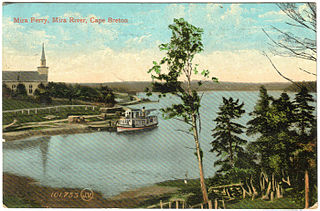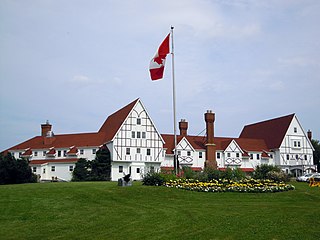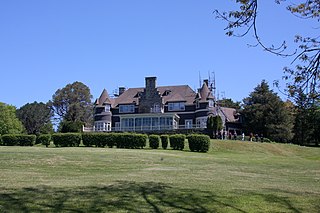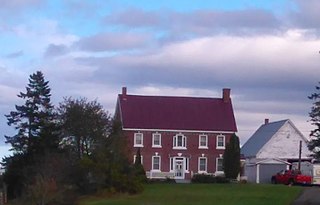Gallery
- front
- front
- side
- Driveway
- Driveway
- Driveway
Fairholme Farm was built in 1894 in Canada by renowned architect George Franklin Barber. It was built on land originally purchased from the Crown in 1827. The farm was built in the style of Queen Anne style architecture, and it is now registered under the Heritage Property Act (Nova Scotia). The property is located in Georges River, Nova Scotia. The family business on the farm started in 1920, and has been running ever since. [1]
Boularderie Island is an island separating the Cabot Strait from Bras d'Or Lake on the eastern coast of Cape Breton Island, Nova Scotia, Canada. It takes its name from Louis-Simon le Poupet de la Boularderie, who was granted the area as a concession from the King of France.

Berwick is a Canadian town in Kings County, Nova Scotia. The town is located in the eastern part of the Annapolis Valley on the Cornwallis River. The town site stretches south from the river and Exit 15 of Highway 101 to Highway 1. Berwick occupies 6.80 km2 and has an elevation of 43 m (141 ft) above sea level.
Florence is a community in the Cape Breton Regional Municipality, Nova Scotia, Canada. The community is located north of Highway 105 and west of Sydney Mines.

Albert Bridge is a Canadian rural community in Nova Scotia's Cape Breton Regional Municipality. Situated on both sides of the Mira River, the community was previously named Mira Ferry for the location of a small ferry crossing the river. It received its present name either in honour of Prince Albert, Prince Consort, or after Albert Munro, the son of William Henry Munro, Nova Scotia's representative in the British Parliament who used his influence to have the ferry replaced with a bridge in 1849.

Point Aconi is a rural community in Nova Scotia at the northeastern tip of Boularderie Island. It derives its name from the headland of the same name, Point Aconi.

Holy Angels was an all-girls high school located in Sydney, Nova Scotia, Canada. It was founded in 1885 by the Sisters of the Congregation of Notre Dame. They bestowed the school with the Latin motto: Angelis Suis Mandavit De Te meaning "He has entrusted you to the care of his angels".
Balls Creek is a community in the Canadian province of Nova Scotia, located in the Cape Breton Regional Municipality on Cape Breton Island. It is located along a creek of the same name, both named after Ingram Ball who was given a grant bordering on the creek in 1795.
Coxheath is a community in the Canadian province of Nova Scotia, located north of the Sydney River in the Cape Breton Regional Municipality on Cape Breton Island. The community is home to Riverview Rural High School, a secondary school with approximately 900 students in Grades 10-12 and Coxheath Elementary.
Big Beach is a community located on the north side of the Boisdale Hills on the east side of the Great Bras D'Or Lake on Provincial Route 223, which runs from Leitches Creek to Little Narrows, through Central Cape Breton Island in the Canadian province of Nova Scotia. Located on the "Bras D'Or Lakes Scenic Drive" it is part of the Cape Breton Regional Municipality in Central Cape Breton Island.
Georges River is a community in the Canadian province of Nova Scotia, located in the Cape Breton Regional Municipality on Cape Breton Island.
Barachois Harbour is a community in the Canadian province of Nova Scotia, located in the Cape Breton Regional Municipality on Cape Breton Island.

Keltic Lodge is a premier resort hotel in the village of Ingonish, Nova Scotia in Canada, on the northeastern coast of Cape Breton Island.

Beinn Bhreagh is the name of the former estate of Alexander Graham Bell, in Victoria County, Nova Scotia, Canada. It refers to a peninsula jutting into Cape Breton Island's scenic Bras d'Or Lake approximately three kilometres southeast of the village of Baddeck, forming the southeastern shore of Baddeck Bay.
Fort Ste. Anne is a former French military fort located at present-day Englishtown, Nova Scotia, on the Island of Cape Breton, Nova Scotia, Canada.

Gilbert H. Grosvenor Hall is a historic building in Baddeck, Nova Scotia, Canada. The 19th-century building has served as a post office, library, and interpretive centre.

The Victoria County Court House is a historic building in Baddeck, Nova Scotia.

Saint Peter's and Saint John's Anglican Church is an historic building in Baddeck, Nova Scotia. The church is one of only four remaining churches designed by Reverend Simon Gibbons, Canada's first Inuit priest. Built in 1883, the church is the second of six churches built by Gibbons in Nova Scotia.
St. Mark's Masonic Lodge is a historic Mason's Lodge located at the corner of Queen Street and Grant Street in Baddeck, Nova Scotia. The Lodge was constructed in 1898 to replace a lodge that had been destroyed in a fire.
The Bras d'Or House is a historic building in Baddeck, Nova Scotia, Canada.

The Chapman House is a National Historic Site of Canada located on Mount Whatley Road in Fort Lawrence, Nova Scotia consisting of a Georgian style brick house and the lot on which it sits.
46°13′37″N60°17′42″W / 46.226991°N 60.295134°W